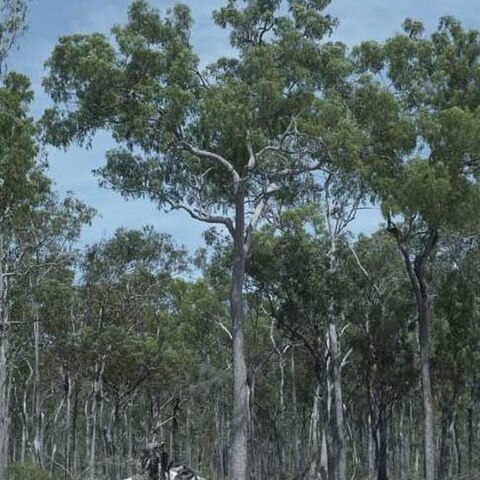Tree to30 m tall. Forming a lignotuber.Bark rough to small branches, grey to grey-brown, tessellated to crumbly.Branchlets lack oil glands in the pith; smooth.Juvenile growth (coppice or field seedlings to 50 cm): stems rounded in cross-section, setose with bristle-glands for at least the lower ca 8 nodes; juvenile leaves always petiolate, opposite for many nodes, or some pairs sub-opposite, predominantly cordate to ovate but may be ± lanceolate to elliptical, 4.8–12.5(23) cm long, 2.3–8 cm wide, base lobed to rounded but often a few leaves peltate, apex of lowest leaves emarginate, then rounded and apiculate or broadly pointed further up the stem, dull, green, discolorous; leaves have sparsely distributed bristle-glands and numerous short white simple hairs on both sides. Bristle-glands are also ornamented with short simple hairs.Adult leaves predominantly alternate but sometimes a few pairs sub-opposite, petioles 0.9–2.3 cm long; blade lanceolate to falcate, 7.3–21 cm long, 0.7–2.8 cm wide, base tapering to petiole, margin entire, apex pointed, slightly discolorous, glossy or only slightly so, green, smooth, side-veins at greater than 45° to midrib, reticulation dense to very dense, intramarginal vein visible but close to margin, oil glands usually present, island and intersectional, one per areole.Inflorescence terminal compound, peduncles relatively slender, 0.5–1.7 cm long, buds 7 per umbel, pedicels 0.3–1.1 cm long. Mature buds obovoid to pyriform, 0.5–0.7 cm long, 0.3–0.5 cm wide, smooth, scar absent (both opercula shed together at flowering), operculum very shallowly rounded and apiculate to shallowly and bluntly conical, stamens inflexed, all fertile, anthers oblong, dorsifixed, versatile, dehiscing by longitudinal slits, style usually long (rarely not reaching the underside of the operculum), straight, stigma blunt and long-papillose, locules 3(4), the placentae each with ca 5 ± distinct ovule rows. Flowers creamy white.Fruit pedicellate (pedicels 0.4–0.9 cm long), thin-walled, urceolate with a neck not or scarcely flared at the rim, if neck short then fruit ± barrel-shaped, 0.8–1.5 cm long, 0.6–1 cm wide, longer than wide, smooth, disc descending vertically, valves 3(4), enclosed.Seeds brown, 6–7 mm long, ellipsoidal with terminal wing, hilum ventral. Cultivated seedlings (measured at ca node 10): cotyledons reniform; stems rounded in cross-section, setose with bristle-glands; leaves shortly petiolate, opposite for at least 8–10 nodes, narrowly elliptical to oblong or lanceolate but becoming broader up the stem, 6–10 cm long, 1–3 cm wide, base tapering to rounded on lower leaves, peltate or lobed after ca node 10, dull, green, discolorous, sparsely setose with bristle-glands and short white simple hairs on both surfaces.
More
Tree to 30 m. Bark tessellated, grey or grey-brown throughout. Juvenile leaves alternate, petiolate, some peltate, broadly lanceolate to ovate, often cordate, setose. Adult leaves alternate, lanceolate to narrowly lanceolate, acute or acuminate, thin; lamina 8–18 cm long, 0.9–1.8 cm wide, green, shining, slightly discolorous; lateral veins faint, at 50°–60°; intramarginal vein confluent with margin; petiole channelled or terete, 9–15 mm long. Umbels 7-flowered; peduncle terete or slightly angled, 7–10 mm long; pedicels 5–8 mm long. Buds clavate; operculum depressed hemispherical, apiculate, 1–2 mm long, 4–6 mm wide; hypanthium truncate-pyriform, 5–6 mm long, 4–6 mm wide. Fruits ovoid or urceolate, 9–15 mm long, 7–9 mm wide, thin-walled. Seeds winged, brown.


